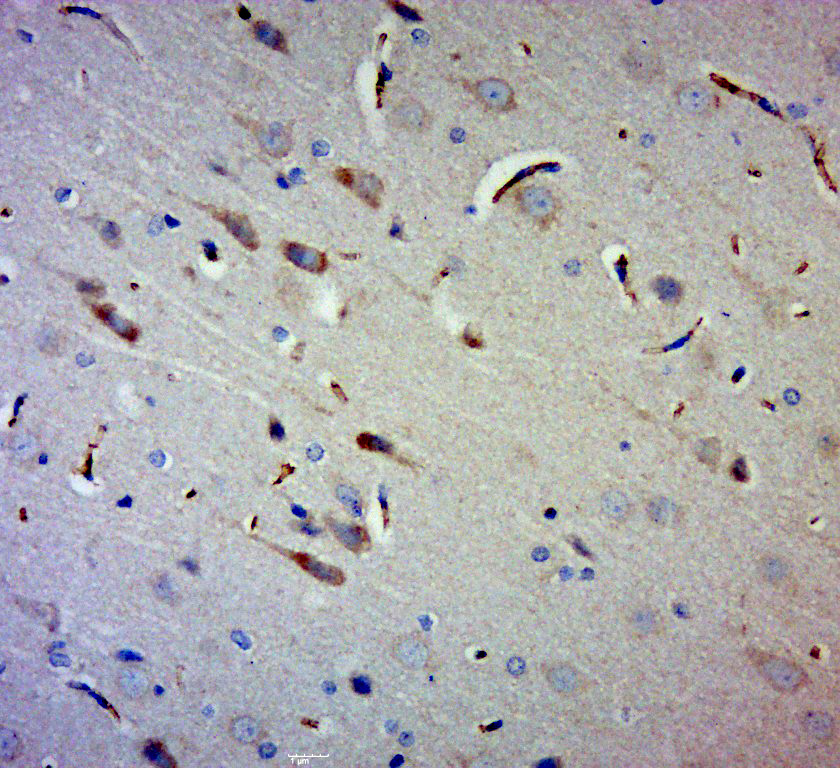
Rabbit Anti-Gigaxonin antibody
FLJ38059; GAN; GAN1; Kelch-like protein 16; giant axonal neuropathy; KLHL16; GAN_HUMAN.
View History [Clear]
Details
Product Name Gigaxonin Chinese Name 巨轴索神经病蛋白GAN抗体 Alias FLJ38059; GAN; GAN1; Kelch-like protein 16; giant axonal neuropathy; KLHL16; GAN_HUMAN. Research Area Neurobiology Signal transduction Cell adhesion molecule Cytoskeleton Immunogen Species Rabbit Clonality Polyclonal React Species Rat, (predicted: Human, Mouse, Pig, Cow, Horse, Rabbit, Sheep, ) Applications ELISA=1:5000-10000 IHC-P=1:100-500 IHC-F=1:100-500 ICC=1:100-500 IF=1:100-500 (Paraffin sections need antigen repair)
not yet tested in other applications.
optimal dilutions/concentrations should be determined by the end user.Theoretical molecular weight 68kDa Cellular localization cytoplasmic Form Liquid Concentration 1mg/ml immunogen KLH conjugated synthetic peptide derived from human Gigaxonin: 351-450/597 Lsotype IgG Purification affinity purified by Protein A Buffer Solution 0.01M TBS(pH7.4) with 1% BSA, 0.03% Proclin300 and 50% Glycerol. Storage Shipped at 4℃. Store at -20 °C for one year. Avoid repeated freeze/thaw cycles. Attention This product as supplied is intended for research use only, not for use in human, therapeutic or diagnostic applications. PubMed PubMed Product Detail Gigaxonin, also refered to as giant axonal neuropathy, GAN1, or KLHL16, controls protein degradation and is essential for neuronal function and survival. Gigaxonin is a member of the cytoskeletal BTB/kelch repeat family and influences cytoskeletal organization and dynamics, playing a large role in neurofilament architecture. The amino terminal BTB domain of gigaxonin binds to the ubiquitin-activating enzyme E1, while the carboxy-terminal kelch repeat domain interacts directly with the light chain of microtubule-associated protein 1B (MAP1B), and tags it for degredation. Overexpression of MAP1B may lead to neuronal cell death, whereas a reduction of MAP1B significantly improves the survival rate of neurons. Mutations in the Gigaxonin gene result in human giant axonal neuropathy (GAN), an autosomal recessive neurodegenerative disorder characterized by axonal degeneration caused by cytoskeletal abnormalities, including accumulated intermediate filaments.
Function:
Mutations in gigaxonin result in a sensory and motor neuropathy called Giant Axonal Neuropathy (GAN). Giant axonal neuropathy, a severe autosomal recessive sensorineural neuropathy affecting both the peripheral nerves and the central nervous system, is characterized by neurofilament accumulation, leading to segmental distention of axons. Gigaxonin is a member of the cytoskeletal BTB/kelch (Broad-Complex, Tramtrack and Bric a brac) repeat family. Gigaxonin contains an N-terminal BTB domain followed by 6 kelch repeats, which were predicted to adopt a beta-propeller shape. Gigaxonin controls protein degradation and is essential for neuronal function and survival. Substrate-specific adapter of an E3 ubiquitin-protein ligase complex which mediates the ubiquitination and subsequent proteasomal degradation of target proteins. Controls degradation of TBCB. Controls degradation of MAP1B and MAP1S, and is critical for neuronal maintenance and survival
Subunit:
Interacts with TBCB. Interacts with CUL3. Part of a complex that contains CUL3, RBX1 and GAN. Interacts (via BTB domain) with UBA1. Interacts (via Kelch domains) with MAP1B (via C-terminus) and MAP1S (via C-terminus).
Subcellular Location:
Cytoplasmic; Cytoskeleton.
Tissue Specificity:
Expressed in brain, heart and muscle.
Post-translational modifications:
Ubiquitinated by E3 ubiquitin ligase complex formed by CUL3 and RBX1 and probably targeted for proteasome-independent degradation.
DISEASE:
Defects in GAN are the cause of giant axonal neuropathy (GAN) [MIM:256850]. GAN is a severe autosomal recessive sensorimotor neuropathy affecting both the peripheral nerves and the central nervous system. It is characterized by neurofilament accumulation, leading to segmental distention of axons.
Similarity:
Contains 1 BACK (BTB/Kelch associated) domain.
Contains 1 BTB (POZ) domain.
Contains 6 Kelch repeats.
SWISS:
Q9H2C0
Gene ID:
8139
Database links:Entrez Gene: 8139 Human
Entrez Gene: 209239 Mouse
Omim: 605379 Human
SwissProt: Q9H2C0 Human
SwissProt: Q8CA72 Mouse
Unigene: 112569 Human
Unigene: 132992 Mouse
Product Picture
Bought notes(bought amounts latest0)
No one bought this product
User Comment(Total0User Comment Num)
- No comment



 +86 571 56623320
+86 571 56623320
 +86 18668110335
+86 18668110335

